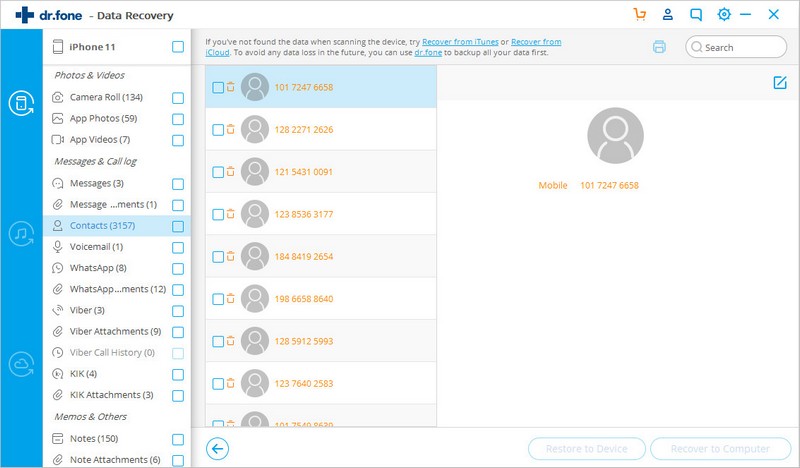I use Mac and iPhone XR,I want to know How to Recover iPhone lost SMS from Mac?
Morning, I pressed the wrong button, I deleted all my important Text Messages from iphone by careless that kept for several years,, I am very upset ! My girl friend now angry with me! Becase I use Macbook,I need to recover iPhone SMS Messages in Mac.Some help would be very much appreciated. Many thanks!!
Many users use iPhone and Macbook.After they update iPhone to more high iOS system,they need to recover iPhone Text SMS Messages in Mac.Fortunately,there are a iPhone Data Recovery for Mac can help you recover all lost iphone SMS messages in Mac,you must Installation this iPhone Data Recovery to Mac,and conntct your iPhone to Mac.You can effortlessly recover lost iPhone SMS directly from iPhone or from iTunes backup for iPhone with Wondershare Dr.Fone (Mac) This Mac iPhone SMS recovery software currently supports SMS recovery from iPhone, iPad series and iPod touch 4G/5G.
You can get a trial version of Wondershare Dr.Fone(Mac) to process iPhone SMS recovery in Mac now. Besides, the Windows version of Wondershare Dr.Fone currently supports SMS recovery directly from iPhone 11/XS/XR/X/8/7/6S/6/5S/5/4S.


2 Ways to Perform iPhone Text Messages Recovery in Mac
Part 1 Directly Recovery iPhone SMS in Mac
Part 2 Recover iPhone SMS from iTunes Backup in Mac
![]() Part 1 Directly Recovery iPhone in Mac
Part 1 Directly Recovery iPhone in Mac
Step 1. Connect iOS Device with Computer
Use the USB cable that comes with your iOS device to connect your iPhone, iPad or iPod touch, to your computer. Then launch Dr.Fone on your computer and choose "Data Recovery".
.jpg)
Once the program detects your device, it will show you the window as follows.
.jpg)
Tips: Before running Dr.Fone, you're supposed to download the latest version of iTunes. To avoid the automatically sync, don't launch iTunes when running Dr.Fone. I suggest you to disable the automatical syncing in iTunes beforehand: launch iTunes > Preferences > Devices, check “Prevent iPods, iPhones, and iPads from syncing automatically”.
Step 2. Scan Your Device for Lost Data on It
Simply click the "Start Scan" button to let this program scan your iPhone, iPad or iPod touch to scan for deleted or lost data. The scanning g process may last a few minutes, depending on the amount of data on your device. During the scanning process, if you see that the data you're looking for is there, then you can click the "Pause" button to stop the process.
.jpg)
Step 3. Preview and Recover the Scanned Data
The scan will take you some time. Once it's completed, you can see a scan result generated by the program. Data both lost and existing on your device are displayed in categories. To filter out the deleted data on your iOS device, you can swipe the option "Only display the deleted items" to ON. By clicking the file type in the left side, you can preview the found data. And you can see there is a search box on the top right of the window. You can search for a specific file by typing a keyword in the search box. Then save the data to your computer or your device by clicking the recovery button.

Tips: About recovering data
When you find the data you need, just put the check mark in front of the box to select them. After then, click the "Recover" button at the bottom right of the window. By default, the recovered data will be saved to your computer. As for text messages, iMessage, contacts, or notes, when you click Recover, a pop-up will ask you to "Recover to Computer" or "Recover to Device". If you want to put these messages back to your iOS device, click "Recover to Device".
![]() Part 2 Recover iPhone SMS from iTunes Backup in Mac
Part 2 Recover iPhone SMS from iTunes Backup in Mac
Step 1. Choose Recovery Mode
Launch Dr.Fone and click "Data Recovery".
.jpg)
Then choose "Recover iOS Data".
.jpg)
You can see three options on the side here. Choose "Recover from iTunes Backup File". After then, the iTunes backup recovery tool will detect all iTunes backup files on this computer and display them in the window. You can confirm which one is the one you need according to the date it has been created.
.jpg)
Step 2. Scan Data from iTunes Backup File
Choose the iTunes backup file that contains the data you want to recover and click "Start Scan". It will take a few minutes to extract all data from the iTunes backup file. Be patient.
.jpg)
Step 3. Preview and Recover Data from iTunes Backup
After a few seconds, all data in the backup file will be extracted and displayed in categories. You can preview them one by one before recovery. Then you can selectively mark and recover those you want by pressing the "Recover" button at the bottom. Now contacts, notes and messages can be directly recovered to your iOS device if you keep your iOS device connected with your computer via a USB cable during the recovery process.
Tips: you can see there is a search box in the result window. From there, you can type in the name of a file to search for it.
.jpg)
Tips: What if your iTunes backup file is located somewhere else?
When your iTunes backup file comes from somewhere, such as moved from another computer with a USB drive, how can you preview and get the content from it? There is a way. When you are at the first step, click "Select" under the list of iTunes backup files, and you can flexibly choose the iTunes backup file no matter where you place it.
.jpg)
Then in the pop-up window, preview and target your iTunes backup file. Then click "Start Scan" and you can move on with the step 2 above. It's pretty useful feature.
.jpg)